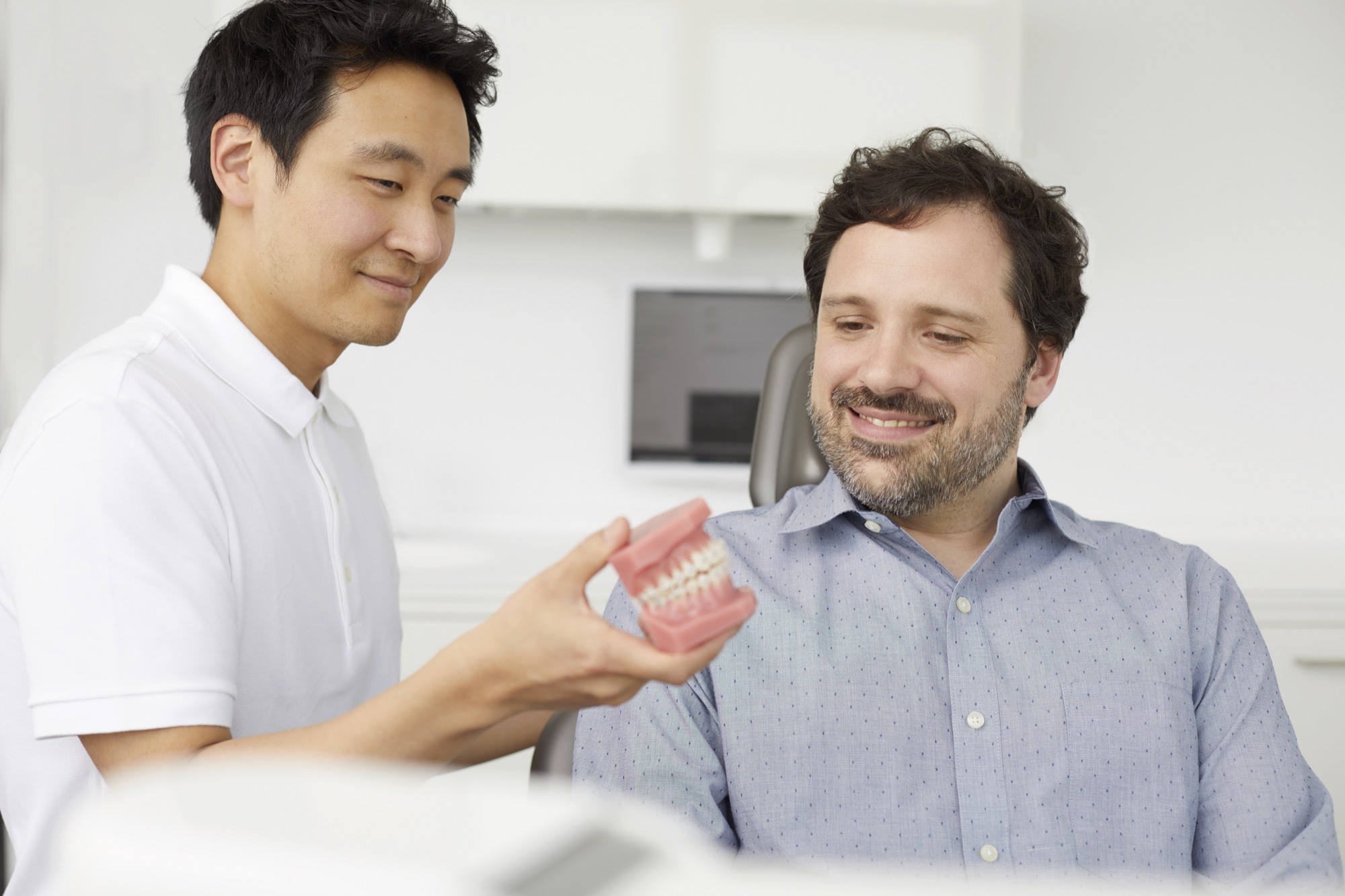
Adults
It is never too late…
Orthodontic treatments can be performed at any age, and we are able to treat individuals with a wide variety of orthodontic concerns, including esthetic treatments. Furthermore, we are knowledgeable about effective treatments that are designed to have little to no impact on your social, professional, and overall appearance.
We work in conjunction with your dentist to ensure optimal success for your orthodontic procedure, which includes good oral hygiene and oral health. We also work in conjunction with specialists in oral-maxillofacial surgery, should surgery be indicated (for example, in severe jaw malalignment).
Please contact our practice in Oberusel should you have questions regarding the services we offer.
Appliances
- Removeable appliances/Functional appliances: Removable appliances are devices that have a variety of different functions and generally require good patient compliance. For example, they can be used to create space for crowded teeth through the use of clasps, screws, or springs which help widen the upper and lower dental arches. Another example of a removable appliance is a space maintainer, which is a device used to move single teeth or, for children, to ensure appropriate space is maintained for the growth of the permanent teeth (for example, if there is premature ‘milk tooth’ loss).Other examples of removable devices include the Double Bite Jumping Plate System, Twinblock and Fraenkel appliances. These are devices that help move teeth and modulate jaw development. They work to guide the bone, muscles and corresponding nerves to treat discrepancies in teeth and jaw distances. They are a noninvasive way of interrupting the harmful oral habits of young children (such as tongue thrusting, finger sucking, and lip biting).
As discussed further below, fixed braces can help properly align teeth. However, they increase the risk of developing caries. Therefore, treatment with fixed braces should start when the second dentition is close to completion and treatment time should be kept as short as possible. During the transition phase, removable appliances can assist with treatment.
- Rapid Palatal Expansion (RPE): This appliance helps with treatment of patients who have a narrow palatal jaw, which is most commonly associated with a crossbite. The crossbite is a type of oral misalignment which occurs when the posterior teeth of the upper jaw are positioned to the inside of the posterior teeth of the lower jaw.
- Braces on the front side of the teeth- Metal braces with spring clips
Traditional braces rely on the use of elastics and fixed wires to straighten teeth; however, this can result in plaque accumulation. In contrast, braces with spring clips use closeable metal clips, which create less friction and pressure than traditional braces. This is more efficient than traditional braces and is associated with less plaque development, and therefore they also have a lower risk of teeth developing “white spots,” which are white areas surrounding the edges of the braces.– Ceramic braces with spring clips
Ceramic braces are another treatment option that use closeable clips, which eliminates the need for the elastics that are associated with traditional braces. Ceramic braces are comfortable to wear because their shape is flat and rounded. Additionally, they are white in color, and are therefore less noticeable on the teeth than traditional braces. Because of their desirable esthetics and comfort, in addition to their good price-performance ratio, ceramic braces are a popular choice for many patients.
Carriere Systems
Carriere Systems help rectify the incorrect connection between the teeth that can result when the upper and lower jaws do not fit together. Because of the need to wear elastics with this system, patient compliance is important. However, the use of the Carriere System can significantly shorten the treatment time needed for fixed appliances or aligners when used before these other treatments are started.
- BioBiteCorrector
The BioBiteCorrector is an orthodontic device that corrects the distance between the front teeth in the upper and lower jaws when the distance is too large. Depending on the patient’s age, it can also correct the retracted position of the lower jaw. This device is favored for its efficiency and effectiveness, in addition to it not requiring the use of elastics or exterior appliances (headgear), which decreases the need for strict patient compliance.
Nearly invisible treatment appliances
- Lingual braces
The lingual braces are fixed braces which are attached to the back of the teeth and are therefore nearly invisible. Lingual braces are able to complete the same tasks as traditional braces but are a popular choice for adults when esthetics are important. These braces are customized to ensure placement is precise; each brace is placed into the one exact position on every tooth. Due to placement on the back of the teeth, there is an acclimation period during the first 2 weeks that may affect word pronunciation and may cause mild tongue irritation. - Removable aligner treatments, like Invisalign®
Our practice strives to offer orthodontic treatments that minimally affect our patients’ esthetics and quality of life while offering optimal comfort. Invisible aligners are one example. They can be worn while playing sports or going about the daily activities of one’s day, making the treatment goal of wearing the aligners 22 hours per day easily obtainable. Additionally, they are removable, ensuring easy access to the teeth when completing tasks of daily oral hygiene. Treatment plans are made at the beginning of treatment, which outline each step to make the process transparent and comprehensible. - Retainer
The fixed retainer stabilizes each tooth’s new position following treatment completion and removal of braces. It is a device that consists of a thin wire attached to the back side of the upper and lower front teeth. This ensures the visible teeth remain aligned following treatment with braces. - Minipins
Minipins are small pins that are attached at the palate and various regions of the upper and lower jaws. They have a wide range of functions and help ensure treatments are performed efficiently while simultaneously decreasing the risk of adverse effects.Minpins have a wide range of uses:
– Movement of the posterior teeth: Minipins help decrease the need for external appliances (for example, headgear), and help decrease the risk of adverse events while the posterior teeth are migrating. This helps decrease the treatment time, as well.– Missing permanent teeth: Congenitally missing lateral incisor teeth are not uncommon, and there are various treatment options to address this. Minipins reduce the treatment time compared to more traditional methods. They also allow for 2 different treatment options: space closure, or space opening with subsequent prosthetic placement. We work with each patient individually to determine the optimal treatment based on the starting positions of the teeth and jaw.
– Preprosthodontic treatment
There are certain scenarios when a gap in the teeth is blocked by adjacent teeth, or when “overhanging” teeth can make a prosthodontic restoration difficult. In these situations, minipins help ensure the necessary treatment is performed discreetly and efficiently, and at times the use of minipins decreases the need to have treatments completed in a region that may be highly visible.
Festsitzende Zahnspangen
Diese Metallbrackets unterscheiden sich von den herkömmlichen Brackets, indem sie sehr klein sind und keine Gummiringe zur Fixierung des Drahtbogens benötigen. Sie sind mit verschließbaren Kläppchen ausgestattet und bieten optimale hygienische Bedingungen. Denn an die Gummiringe der herkömmlichen Brackets können sich vermehrt Bakterien anlagern, was die Gefahr der Kariesbildung erhöht. Diese Brackets sind silberfarben und somit obliegt die Entscheidung dem Patienten, ob diese für den beruflichen und privaten Alltag in Frage kommen. Alternativ stehen nahezu unsichtbare festsitzende Behandlungsapparaturen wie Keramik- oder Lingualbrackets zur Wahl. Transparente herausnehmbare Schienensysteme stellen natürlich auch eine Alternative dar.
Im Gegensatz zu den Metallbrackets stellen die weißen Keramikbrackets eine unauffälligere Lösung dar. Diese Bracketsysteme sind weiß, abgerundet und flach. Somit bieten sie einen hohen Tragekomfort kombiniert mit einem attraktiven Preis-Leistungs-Verhältnis, so dass zahlreiche Jugendliche und Erwachsene sich für diese Art von Zahnspange entscheiden. Diese Brackets bieten im Gegensatz zu den Metallbrackets ästhetische Vorteile, bleiben jedoch zu einem geringen Grad sichtbar und weisen eine höhere Anfälligkeit für Verfärbungen auf.
Nahezu Unsichtbare Zahnspange
Die innen befestigte Zahnspange eignet sich für diejenigen Patienten, bei welchen eine feste Zahnspange zur Behandlung der Zahn- und Kieferfehlstellung indiziert wäre, die jedoch auf der Suche nach einer unauffälligen und nahezu unsichtbaren Lösung sind. Diese ermöglicht erwachsenen Patienten ihren Pflichten im alltäglichen Berufsleben uneingeschränkt nachzugehen. Alle Zahnbewegungen, welche mittels der außenliegenden Zahnspange möglich sind, sind auch über die innenliegende Zahnspange durchführbar. Alle Bestandteile der Zahnspange werden individuell für den Patienten angefertigt, so dass diese eine hohe Präzision aufweisen. Die Zahnspange bedarf einer Eingewöhnungsphase, welche individuellen Schwankungen unterliegt. Besonders die Zunge und die Aussprache könnten in der Anfangsphase bzw. nach dem Einsetzen der Zahnspange Einschränkungen erleiden.
Mit dem Schienensystem ergeben sich kaum Einschränkungen der Lebensqualität und es vereint Ästhetik, Tragekomfort und Transparenz. Eine tägliche Tragezeit von 22 Stunden ist jedoch zur Erreichung des Behandlungszieles erforderlich. Es gibt eine effiziente Methode, die Behandlungsdauer um bis zu 50 Prozent zu reduzieren. Gerne geben wir Ihnen hierzu mehr Auskunft bei einem gemeinsamen Beratungsgespräch in unserer Kieferorthopädie Oberursel.
- Keine Einschränkungen der Lebensqualität: Im Gegensatz zur festen Zahnspange hat man die Möglichkeit, die Schienen zu entfernen und gewünschte Speisen zu sich zu nehmen. Dabei entfällt die Gefahr, dass sich Speisereste an Spangenteilen festsetzen können.
- Ästhetik: Die Schienen sind nahezu unsichtbar und ermöglichen eine unauffällige Therapie ohne Zahnspangenanteile und Drahtbögen.
- Tragekomfort: Die Schienen bieten im Gegensatz zur festen Zahnspange einen hohen Tragekomfort und zugleich besteht nicht die Gefahr, dass sich Spangenanteile lösen oder bestimme Teile wie der Drahtbogen an der Mundschleimhaut Beschwerden verursachen.
- Transparenz: Jedem Patienten wird der Behandlungsprozess in digitaler Form zur Verfügung gestellt (sog. ClinCheck). Das Endergebnis kann bereits vor Behandlungsbeginn eingesehen und zusätzlich die geplanten einzelnen Therapieschritte mitverfolgt werden
Nach einer aktiven kieferorthopädischen Behandlung ist oftmals ein Retainer sinnvoll, da er das erreichte Ergebnis stabilisiert. Ein Retainer ist ein dünner Draht, welcher an der Innenseite der Schneidezähne (meist von Eckzahn zu Eckzahn) befestigt wird, um auf diese Weise den Rückfall bzw. das Zurückbewegen der Zähne in die ursprüngliche Position zu verhindern.
Minipins
Die kleinen Schrauben, Minipins genannt, werden im Kiefer eingesetzt, um Bewegungen von Zähnen zu ermöglichen, welche ansonsten nur mit großem Aufwand und eventuell mit Nebenwirkungen oder sichtbaren Außenspangen möglich wären. In vielen Fällen wird hierdurch eine Verkürzung der Behandlungszeit erreicht. Bei erwachsenen Patienten können die Minipins in folgenden Situationen eingesetzt werden:
Wenn ein Nachbarzahn die prothetisch zu versorgende Lücke blockiert oder ein Zahn des Gegenkiefers eine regelrechte prothetische Versorgung nicht zulässt, kann das Minipin genutzt werden, um die Therapie unauffällig und effizient durchzuführen.
Wenn die Zähne im Front- oder Seitenzahnbereich gravierende bzw. unphysiologische Höhenunterschiede aufweisen, kann sich dies ungünstig auf die Abbeißfunktion, die Ästhetik und das Wohlbefinden des Patienten auswirken. Die Abbeißfunktion wäre zum Beispiel beeinträchtigt, wenn die Ober- und Unterkiefer-Zahnreihe keinen Kontakt zueinander aufweisen würden. Wir beraten Sie zum Thema Minipins sehr gerne persönlich in unserer Kieferorthopädie in Oberursel.


